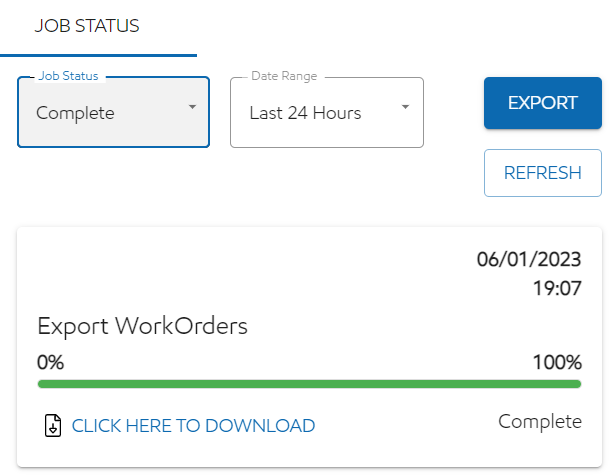Work orders
Work orders are one of the two main methods of completing work in Utility Cloud, the other being scheduled work. A work order is any workflow scheduled against a particular asset, and can created with a variety of scheduling details and assigned to any number of users or none at all. They can be created individually directly on an asset, in bulk from a route, and based on conditions through workflow or asset class triggers.
Searching for work orders
You can search for any work orders that share an account with you from the Work Order Search page, found by selecting the Work Orders tile from the Landing Page or the navigation bar. By default, your most recently performed search displays on the page set to card view. In addition to card view, you can view your search results by list view, chart view, and calendar view.
Quick search

You can quickly find the work orders you're looking for through the quick search. To find a work order through the quick search:
Select the Work Orders tile from the Landing Page or from the quick navigation menu.
Select an account from the account dropdown.
Enter your criteria in the search bar, then select Search .
A quick search will return all work orders where your criteria matches the work order description, work order ID, workflow , asset description, asset ID, and assignee. By default, only open work orders are returned, but you can also return work orders of all other statuses by unselecting Open Only.
Security Rights Required: View Works
Advanced Search

You can be much more precise in which work orders are returned through an advanced search. To find a user through the advanced search:
Select the Work Orders tile from the Landing Page or from the quick navigation menu.
Select Advanced.
Below Advanced Search, select any facet.
Where applicable, select an operator for that facet (such as equals, contains).
Where applicable, enter your criteria after the operator.
If necessary, select Add rule to add a new rule to your search or Add group to add a group of rules. By default, rules are set to AND. If necessary, select OR to change the conditions.
If you've added a group or rule you don't need, select Delete to remove it.
Once your criteria is finished, select Search.
Advanced search will return all exact matches based on the criteria you entered for each facet.
Security Rights Required: View Works
Card view
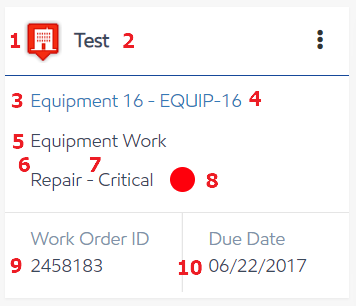
In card view, search results show as a card with the following information displayed:
- Asset icon
- Work order description
- Asset description
- Asset ID
- Workflow
- Type
- Priority
- Status
- Work order ID
- Due date
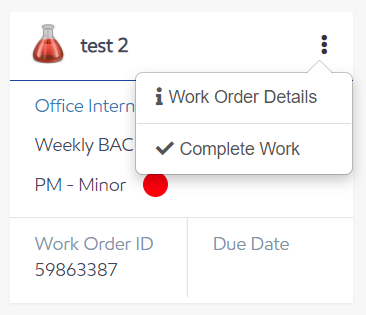
Depending on a work order's status, you can either navigate to that work order's Work Order Details or complete that work order on the workflow Report Editor.
You can switch to card view from any other view by selecting Card View 
List view

In list view, your work orders show in a list with sortable headers. You can sort by selecting the column header title and filter by entering a filter value in the text box. You can also show or hide columns by selecting which columns you'd like to see in the Show/Hide Columns dropdown. The headers include:
- Work Order Description
- Work Order ID
- Asset Description
- Asset ID
- Workflow
- Start Date
- Type
- Priority
- Status
- Created from Trigger
- Account
Selecting any work order in the list will bring you to the Work Order Details of that work order.
You can switch to list view from any other view by selecting List View 
Chart view

In chart view, you're shown an overview of the work orders in your current search results. This includes an overview of your due, open, and completed/closed work orders, as well as three charts showing your work orders by asset class, workflow, and assignee. You can switch which chart is the primary by selecting any of the smaller secondary charts.
You can switch to chart view from any other view by selecting Chart View 
Calendar view
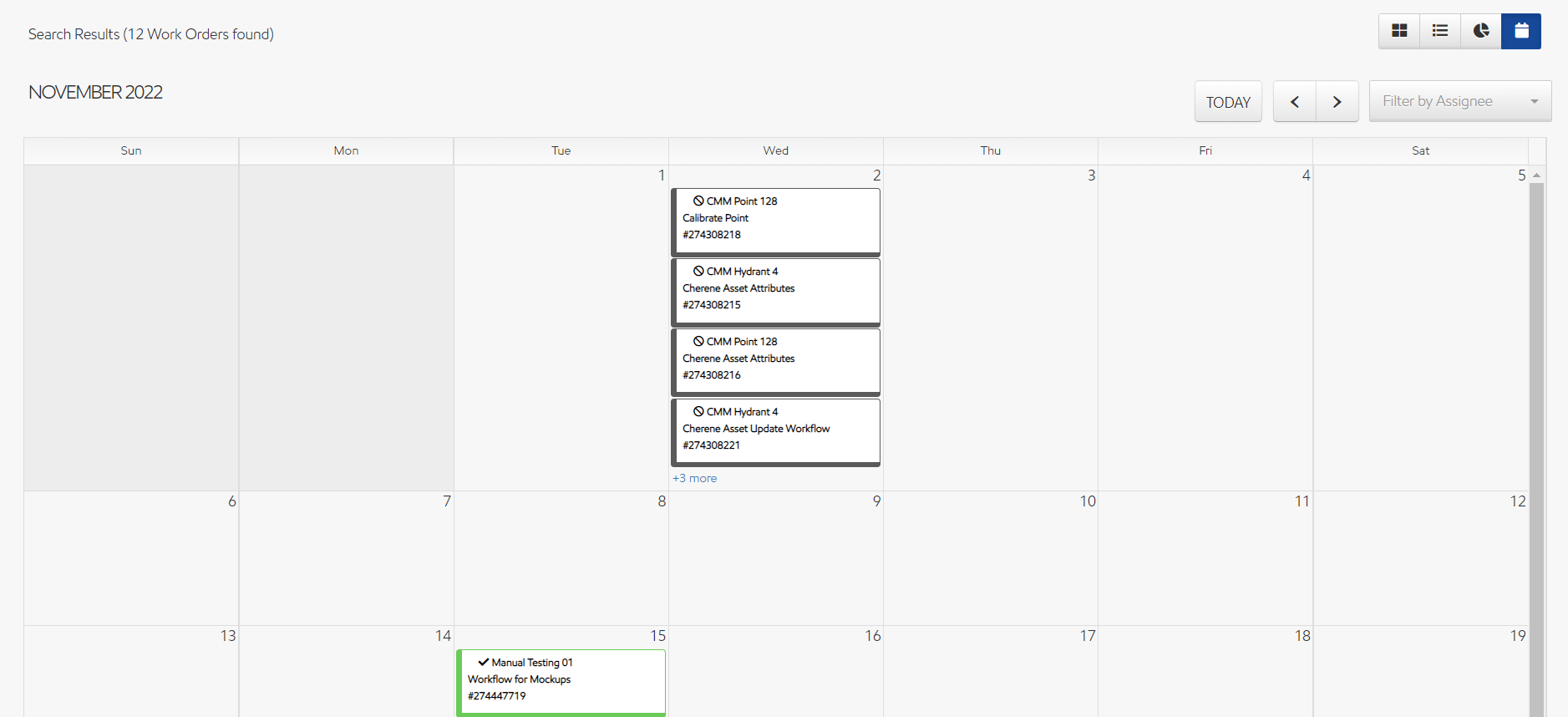
In calendar view, you're shown the work orders of your current search on a calendar, defaulting to the current month. Each work order shows as a card with the below information available:
- Asset description
- Workflow
- Work order ID

Each work order also has its status indicated by color and icon. Depending on a work order's status, you can navigate to that work order's Work Order Details, edit it, complete it, cancel it, or close it. You can also edit an open work order's due date by dragging and dropping from one date to another.
You can switch to calendar view from any other view by selecting Calendar View 
Exporting work orders

From any view on the Work Order Search, you can select Export to export your current search results to Excel.
Perform any search in the Work Order Search.
Select Export and confirm in the upper right corner of the page.
Once your export is completed, you will be notified either from the job processing panel or an email and download your file from there.
For job processing:
Select Complete once your job has been completed.
If it isn't already, set Job Status to Complete.
On the job card, select Click Here To Download.
For email:
In your inbox, search for an email from postmaster@utilitycloud.us with the subject "WorkOrder Export Complete".
Follow the link to download your export.
Your work order's details
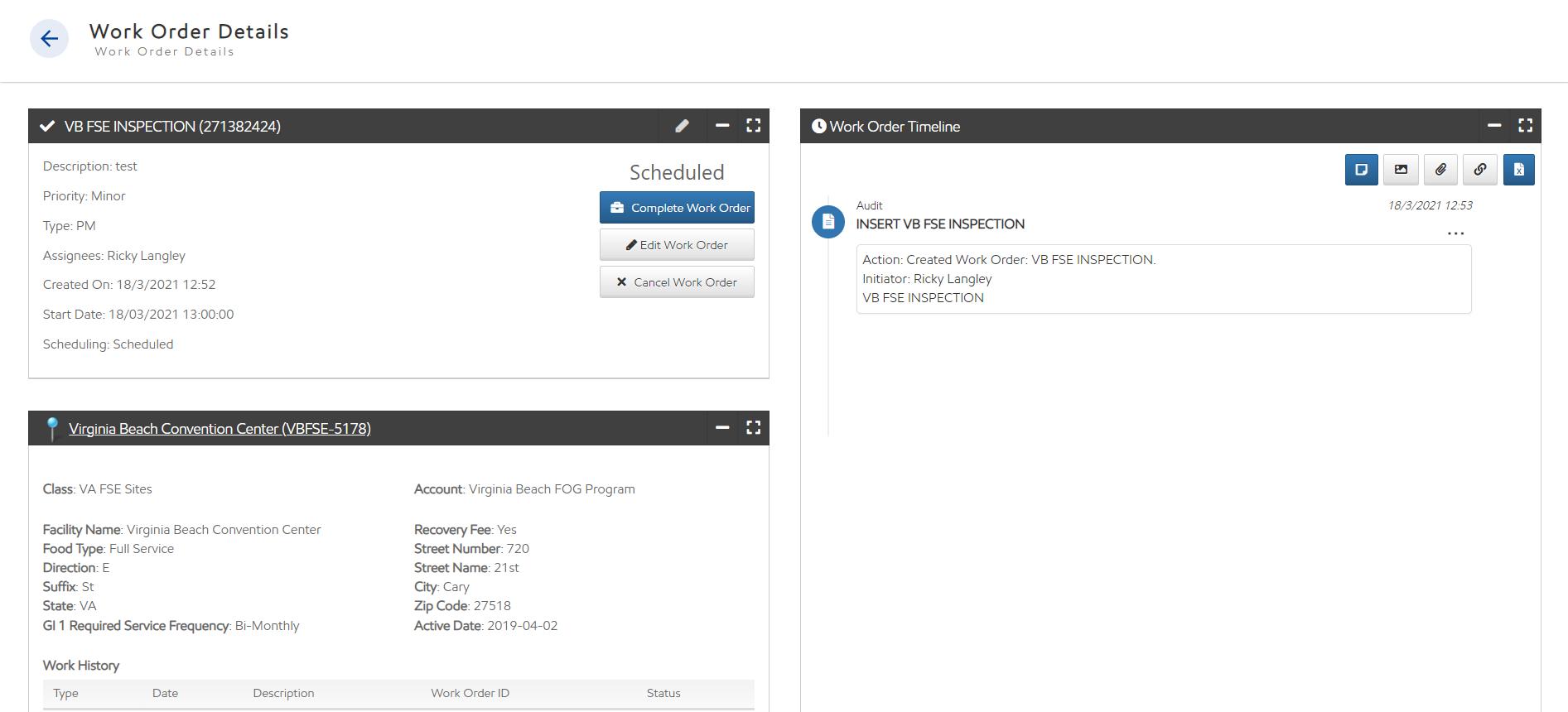
A work order's general details, scheduling, assignees, and other information can be found on the Work Order Details page of that work order. The Work Order Details page can be accessed from most areas of Utility Cloud where you would see a work order.

The main panel contains a work order's details and depending on the status of the work order, options to complete, edit, cancel, close, or reopen that work order. The work order's details can include any of the below attributes, and can be changed when editing a work order:
- Workflow: The work to be performed when completing the work order.
- Work order description: A simple description of your work order to give your users additional insight into the work that needs to be done.
- Type: The type of work that the work order represents generally, set from a predefined list. Common types include repair or preventative maintenance.
- Priority: The priority of a work order, set from a predefined list. Common priorities could be high, medium, or low.
- Tags: A simple text label to group work orders together so they can easily be found through the Work Order Search. Not to be confused with asset tags.
- Scheduling: The scheduling details of your work order.
- None: Work orders with their scheduling set to none won't have a specific due date but will immediately show as due on creation.
- Scheduled: Work orders set to scheduled will have a specific due date. Once that date passes, they will then show as due.
- Reoccurring: Work orders set to be reoccurring will have a specific due date, but also reoccur on a regular basis. They can either reoccur based on their start date or based on when a user completes a work order.
- Reoccurs every: How frequently your work order should reoccur. This can be set to any number of hours, days, weeks, months, or years.
- Start date and start time: The due date of your work order, as well as the date future occurrences will reoccur from if set to reoccur from start date.
- Reoccur from: Whether your work order should reoccur based off of its start date or the date it's completed.
- Start date: When a work order is set set to reoccur from start date, the next work order will be automatically created on a schedule. Its start date will be based on the start date of the previous work order and the interval selected in reoccurs every.
- Completed date: When a work order is set to reoccur from completed date, the next work order will be created when completing the current work order. Its start date will based on the previous work order's date of completion and the interval selected in reoccurs every.
- Hide until next occurrence: When a work order is set to hide until next occurrence, that work order will not be visible until its start date has passed.
- Expire open work orders on the next occurrence: When a work order is set to expire on next occurrence, it will automatically expire and no longer be available to complete when the next work order is created or revealed if hidden. Otherwise, previous occurrences of work orders will remain.
- Ends: The conditions that will stop your work orders from reoccurring.
- Never: Your work orders will continuing reoccurring indefinitely.
- After a number of occurrences: Your work order will reoccur after a set number of times.
- On a certain date: Your work order will reoccur until a certain date.
- Reoccurs every: How frequently your work order should reoccur. This can be set to any number of hours, days, weeks, months, or years.
In addition to the main panel, the Work Order Details page contains an asset panel with your asset's details and recent work history, and the work order timeline panel, containing audits of your work order's history.
Security Rights Required: Can View Work Order; Can Edit Work Order; Can Complete Work; Can Close Work Order
Work order status
The status of a work order determines what actions you can perform against those work orders, from completing the work, editing your work order, or canceling it, among other things.
Open
Any work order that is not started or completed. Anyone with the rights to complete work can complete or edit an open work order. Additionally, any open work order can be canceled or saved as a draft.
From the Work Order Search and Route pages, open work orders will show as blue.
Security Rights Required: Can Complete Work; Can Edit Work Order; Can Save Work Order As Draft; Can Close Work Order
In progress
Any work order that's started been started and saved as a draft but not yet completed. Anyone with the rights to complete work can complete or edit an in progress work order, or resave it as a draft without completing. Like open work orders, an in progress work order can also be canceled, but when it is, its draft workflow report will be discarded.
From the Work Order Search and Route pages, in progress work orders will show as yellow.
Security Rights Required: Can Complete Work; Can Edit Work Order; Can Save Work Order As Draft; Can Close Work Order
Complete
Any work order that's submitted as complete. Anyone with the right to complete work can submit an open or in progress work order as complete, but you can only update the associated workflow report if you have the security right Edit Workflow Report. Once completed, you can close a work order but otherwise can't edit it.
From the Work Order Search and Route pages, complete work orders will show as light green.
Security Rights Required: Can Complete Work; Edit Workflow Report; Can Close Work Order
Closed
Any completed work order can be moved to the closed status. Closing a work order is an optional final step after completing a work order, intended to represent work that was reviewed following submission for completion and accuracy. You can reopen a closed work order back to the completed status but otherwise can't edit a closed work order.
From the Work Order Search and Route pages, closed work orders will show as dark green.
Security Rights Required: Can Complete Work; Can Close Work Order
Canceled
Any open or in progress work order can be canceled if it's no longer needed. You can also reopen any canceled work order back to the open status.
From the Work Order Search and Route pages, canceled work orders will show as light gray.
If you cancel an in progress work order, any draft workflow report against it will be discarded. If that work order is reopened it will need to be completed again fresh.
Security Rights Required: Can Complete Work; Can Close Work Order
Expired
Expired work orders are any reoccurring work orders that were set to expire on next occurrence and not completed by their next occurrence. You can't complete or reopen a work order once it's been expired.
From the Work Order Search and Route pages, canceled work orders will show as dark gray.
Creating work orders
You can create work orders in multiple different ways, but the primary method of creating a work order is from either the Asset Search or Asset Details.
Creating from the Asset Search
From the Asset Search, you can create a work order from any asset's asset card.

To create a work order from the Asset Search:
- Select Create Work Order from the asset card of any asset in your search results.
- Enter the details of your work order:

- Select the workflow for your work order. Any workflow assigned to your asset's asset class and configured as available for use in work orders will be available.
- Enter your work order's description and other details.
- Select any assignees for your work order.
- Select your work order's scheduling details.
- Select Create.
Once your work order is created, it will show on your asset in the Asset Search and Asset Details and all other areas you're able to view work orders.
Security Rights Required: View Assets; Can Create Work Order; Can Assign Work Order
Creating from the Asset Details
From the Asset Search, you can create a work order from any asset's asset card.
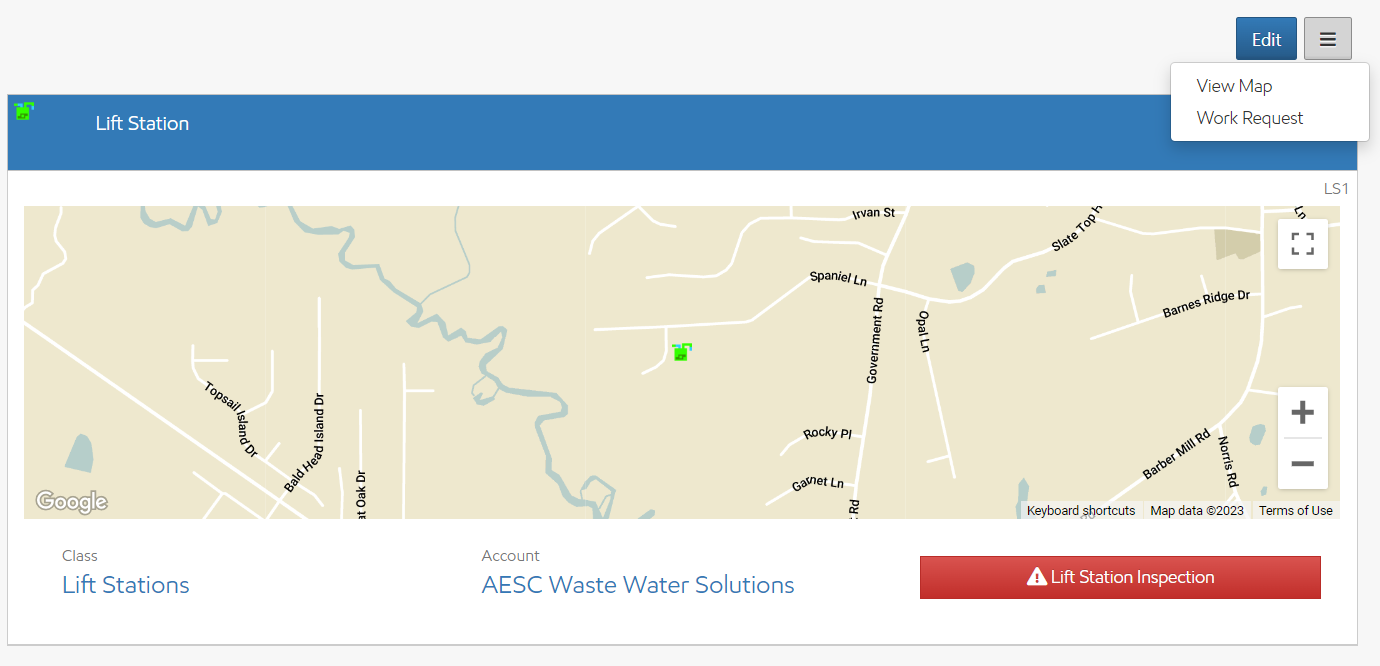
To create a work order from the Asset Details:
- Select Work Request from the upper-right dropdown of your asset's Asset Details.
- Enter the details of your work order:

- Select the workflow for your work order. Any workflow assigned to your asset's asset class and configured as available for use in work orders will be available.
- Enter your work order's description and other details.
- Select any assignees for your work order.
- Select your work order's scheduling details.
- Select Create.
Once your work order is created, it will show on your asset in the Asset Search and Asset Details and all other areas you're able to view work orders.
Security Rights Required: View Assets; Can Create Work Order; Can Assign Work Order
Creating from triggers
Any workflow or asset class can be set to create a work order based on certain trigger conditions. If those conditions are met when completing work or saving an asset, that work order will be created. You can find more information on creating a work order trigger here.
Creating from a route
Routes are a tool in Utility Cloud to bulk create work orders against multiple assets with the same scheduling details for their work orders. You can find more information on creating and managing routes here.


